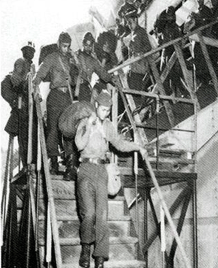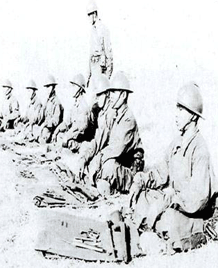 Thailand
Thailand
List for UN Allies
Background of Participation
With the UN resolution to assist South Korea, Thailand informed the UN of its supply of grains to South Korea on June 30th. As the UN Secretary-General had requested Thailand to dispatch ground forces on July 14th, the Thailand government offered to send ground forces of brigade size, composed of 4,000 soldiers.
In addition, upon deciding to dispatch naval forces to Korea, Thailand organized, on October 1st, a naval squadron composed of two frigates and one transport ship. But, around that time, as the war situation improved with the UNs march to the north, the size of ground forces was reduced to that of one battalion.
The naval squadron, carrying ground forces in one battalion size and red cross medical units, arrived in Pusan on November 7th. The Thai Battalion moved to the UN camp at Daegu. Its naval forces moved to Japan to be attached to the US Far Eastern Navy.On June 18th, Thailand attached one transport squadron and air medical unit to the US 374th Air Corps in Japan. Thus, Thailand became the fifth country to dispatch Army, Navy, and Air Force units to the Korean War.
The Activity of the Ground Forces
On December 15th, the Thai Battalion moved to Kaesong to cover the UN forces retreat from Pyongyang. As UN troops set up defensive position along the 38th parallel, the Battalion moved to Suwon to act as a reserve unit of the US 8th Corps on December 13th. The Battalion advanced to Shindun-ri, north of Seoul, on January 2, 1951. It was attached to the British 29th Brigade.
The next day, the Thai ground forces for the first time engaged in a battle with CCF which had infiltrated into the 29th Brigade. The enemy was repelled. The battalion retreated to Suwon.
On March 7th, the Thai forces moved to south of Chunchon to participate in the counterattack operations. From March 28th, the Battalion, joined with US tank units. They advanced to Hwachon reservoir, and engaged in a reconnaissance battle. In this combat, the Thai soldiers captured 22 Chinese soldiers and rescued 4 Americans, But they suffered 1 death and 11 wounded. On April 28th, the CCF launched the April offensive. It attempted to advance to Seoul. The Thai Battalion fought a fierce battle in Chang-dong, in which they killed 32 Chinese soldiers. By July 31st, the Thai forces advanced to near Yuldong. On August 18th, the 2nd Company launched a surprise attack on the enemy assembly area near Hill 346, south of Yokgogchon, killing 70 solidiers of the enemy and destroying a large amount of supply goods.On October 19th, the Battalion moved to Mt. Chondog, west of Cholwon, and set up a defensive position in south of the Hill T-bone. At midnight of November 13th, Chinese forces launched a surprise attack on an outpost platoon. The platoon repelled them through hand-to-hand combat. On December 15th, the Battalion was attached to the 9th Regiment of the US 2nd Division because the 1st Cavalry Regiment returned to Japan.
During the first half of 1952, the Thai Battalion carried out the operations of reconnaissance and ambush without serious engagement with the enemy. On October 22nd, the Battalion was deployed on the main resistance line at Homak-ri, west of Chulwon. At midnight of October 27th, the Battalion killed 20 and captured 3 of the enemy by surprise on the Hill Bokgae in front of the main resistance line. On November 1st, as a response to the defeat, CCF attacked the Hill Porkchop after preparation fire. It was the most desperate battle fought by the Thai Battalion ever, in which 50 enemy soldiers were killed while 8 Thai soldiers were killed and 14 wounded. The US 8th Corps gave Thai soldiers a nickname, the little tigers, admitting their courage.
On July 17, 1953, CCF launch an attack on Sadong in order to capture the region before the armistice. But Chinese forces surrendered to the little tigers and retreated after a fierce offensive and defensive battle.
Activity of the Navy
Thai frigates, the Prasae and the Bangpakong, and the transport ship Sichang, which had been attached to the US Far Eastern Navy, were committed to the operation of covering sea routes from the US naval base in Japan until the end of December 1950.
The Prasae and the Bangpakong sailed to the East Sea on January 3, 1951. But the Prasae was stranded off the coast of Sokcho on January 7th. Thai soldiers did their best to rescue the ship, but 2 were killed and 23 wounded. The Commander of the 95th Task Fleet, judging that it would be hard to repair, sank the Prasae.
As the Sichang returned home on Thailands request on July 15th, only the Bangpakong remained in Korea. Thus, Thailand was supplied two frigates from the US on October 29th. It named them the HMTS Prasae II, and the HMTS Tachin. They concentrated on naval training until December 20th. Afterward, Thai vessels supported the UN Navy by carrying out the missions of providing cover until the signing of the armistice on July 27, 1953.
Activity of the Air Force
On June 13, 1951, three C-47 transport planes of Thailand were attached to the 21st Air Battalion of the US 135th Air Division. At that time, C-47 of the US Air Force did not have medical facilities. C-57 transport planes had difficulties in operating at Korean airports with short runways. Consequently, C-47s of Thailand, which were equipped with medical facilities, took exclusive charge of the mission of emergency evacuation. They evacuated mainly serious patients from Korean to Japan.
In 1952, the US Far Eastern Air Force changed C-54s of two Air Company to C-124s in order to increase the capability of transportation. But there were only 4 airports in Korea where C-124s could land and take off. Accordingly, in transporting emergency supplies, C-47s were more suitable. This increased the operations of Thai transport planes. From February 1953, the Greek Squadron took exclusive charge of the mission of transportation within Korea. Thus, Thailand carried out its missions within Japan until the armistice.
Thailand participated in the Korean War by dispatching 3,650 soldiers. They suffered 129 casualties and 1,139 wounded. After the armistice, the ground forces withdrew in 1954 while a company remained in Korea until June 1974. The Navy withdrew in January 1955, and the Air Force in November 1964.

